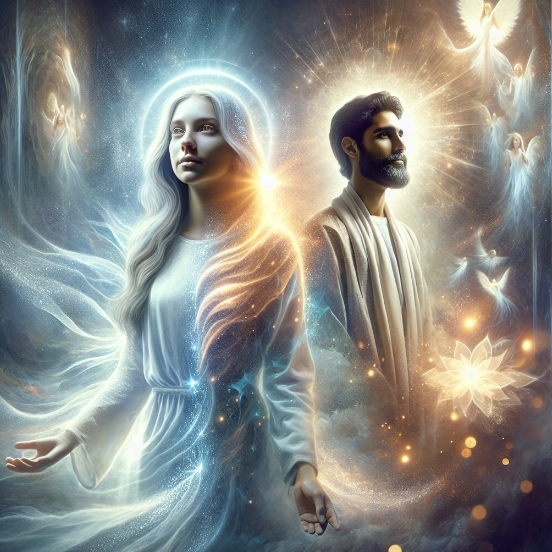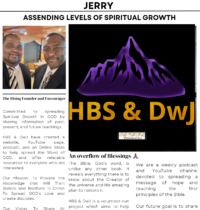The woman is taken from Adam, from the side of Adam. God didn’t take her from the head to be his superior, or from his foot to be his inferior, but He took her from his side to be equal with him, to be along with him.
That is exactly the purpose: she is to be the other half of man. This is exactly what God meant when He said, “Wives, submit to your husbands.” He means that she is to respond, to answer to him. A wife is the other part of him, the other half of him. He is only half a man without her.
Believe me, Eve was beautiful. Any woman today who is beautiful inherited it originally from mother Eve. There is no beauty that she did not have. She was a doll, let me tell you! And she was the other half of Adam.
Genesis 2:21-25 KJV
[21] And the LORD God caused a deep sleep to fall upon Adam, and he slept: and he took one of his ribs, and closed up the flesh instead thereof;
[22] And the rib, which the LORD God had taken from man, made he a woman, and brought her unto the man.
[23] And Adam said, This is now bone of my bones, and flesh of my flesh: she shall be called Woman, because she was taken out of Man.
[24] Therefore shall a man leave his father and his mother, and shall cleave unto his wife: and they shall be one flesh.
[25] And they were both naked, the man and his wife, and were not ashamed.
Genesis 2:21
And the LORD God caused a deep sleep to fall upon Adam, and he slept; and he took one of his ribs, and closed up the flesh instead thereof.
This point of scripture records the first anesthesia. Deep sleep — probably an ecstasy or trance like that of the prophets, when they had visions and revelations of the Lord, for the whole scene was probably visible to the mental eye of Adam, and hence his rapturous exclamation.
Took one of his ribs — “She was not made out of his head to surpass him, nor from his feet to be trampled on, but from his side to be equal to him, and near his heart to be dear to him.” The word “rib” here actually means “side”. The woman is not merely of a rib, but actually of one side of man.
God now acts to address the man’s incompleteness. This is a multi-step process, the first of which is for God to cause a deep sleep to fall upon Adam.
The Hebrew word rendered deep sleep is used in two other places where the Lord acts in a literal, physical way on individuals: regarding Abram in Genesis 15: 12 (lesson 6 ), and regarding Saul and his companions in 1 Samuel 26: 12.
Other uses of this word are found in Job 4: 13 ; 33: 15 ; Proverbs 19: 15 ; and Isaiah 29: 10. It is during this divinely induced anesthesia that the Lord proceeds to the next two steps: removing one of Adam’s ribs, then closing the flesh.
In the Old Testament, God sometimes works while people are in a divinely induced sleep (see Genesis 15:12; 1 Samuel 26:12). Here, Adam needs to be under heavy anesthesia while God removes a certain part of him.
The Hebrew term that is behind the word ribs occurs over two dozen times in the Old Testament, but it is translated “rib(s)” only in the verse before us and the next. Nowhere else in the Old Testament does it have anatomical significance.
Instead, the term’s other usages frequently describe the side or sides of objects (example: Exodus 25:14). With those instances as a guide, we are confident in concluding that God uses the man’s side and/or something from it in what happens next.
In verse 18, God declared that He would make a helper for the man, since it was not good for the man to be alone. Then in the following two verses, Adam goes through the process of naming all of the animals God had created. In doing so, he finds out first-hand that none of them can serve as a suitable helper for him.
Even as God creates, He often does so with the intent of modifying that creation later on (Genesis 1:9–12). So now God goes to work, taking action to complete his intended design of the human race. He causes a deep sleep to fall on Adam: the first anesthesia before surgery.
While Adam is asleep, God removes one of Adam’s ribs and closes up the place with flesh. It’s amazing to think of the God who had formed Adam out of dust now performing surgery on the man’s body of flesh, blood, and bone.
It’s important to remember several things about this action. This surgery was not to remove an imperfection from Adam’s body, but to add something essential and beautiful to Adam’s existence. It also speaks powerfully of the symbolic connection between man and woman.
God could have created woman out of earth, as he did with man, but chose not to. The exchange of wedding rings, circumcision, communion, and other rituals are real-world actions with symbolic importance. In the same way, God’s creation of woman from the rib of Adam meant to be seen as both literal and figurative.
Genesis 2:22
And the rib, which the LORD God had taken from man, made he a woman, and brought her unto the man.
The Hebrew says, “built He a woman”. Horton says, “When God created the man, the word ’form’ was used, which is the same word used of a potter forming a clay jar. But the word ’build’ here seems to mean God paid even more attention to the creation of the woman”
This presents a formal presentation, with God, in essence, performing the first wedding. Thus He instituted the bonds of the Marriage Covenant, which is actually called the Covenant of God [Prov. 2:17], indicating that God is the Author of this sacred institution.
This is the marriage model, and was instituted by God. According to the Word of GOD any other model of marriage can be constituted as none other than an abomination in the Eyes of God [Rom. 1:24-28].
This very brief account of God’s creation of a woman raises a question: why create the woman from the man’s rib?
Many have suggested a special symbolism: woman is made from the “side” of the man so that she will be neither “above” him nor “beneath” him, but always by his side to encourage him. The Bible is silent regarding such symbolism.
Scripture simply pulls back the curtain on this very sacred moment, gives us a quick glimpse of what happens, and then closes the curtain. We would not know of this account at all had not God chosen to reveal it to us.
The primary point behind the description of the woman’s creation seems to be the special care that God takes to solve the man’s incompleteness. The woman is not created from the dust of the ground as was the man; rather, she is created from the man.
The psychological importance of this fact is revealed in the next verse. In keeping with the pattern in Genesis 1, the high point of which is 1:26, 27, God saves the best of His creation for last.
From the records of Israel’s neighbors later on, we sometimes find alternative accounts of human origins, but none of them includes special mention of the creation of women in particular.
In Genesis 1 and 2, women bear the image of God as men do, serve as co-rulers of God’s creation, and play equally important roles in advancing God’s purposes.
It is intriguing that the original word behind the translation made is used elsewhere as an architectural term to describe the construction of cities and altars (examples: Genesis 4:17; 12:7).
What the author describes with a bare minimum of detail is in fact more profound than any construction project that humans themselves can undertake—ever.
The previous verse described God’s removal of Adam’s rib. Now God uses that rib to build a woman. Of course, the ultimate reasons why God chose to work in this way are a mystery to us.
To this point, the only description of God’s creative process has been of forming man and animals out of the earth, the dust of the ground.
He could have formed this woman in the same way, but chose not to. Most likely, this was in order to emphasize the nature of the relationship between men and women.
God’s creation of Adam used the Hebrew word yi’ser, which represents taking some existing substance and molding it into shape.
In the case of woman, however, the Hebrew root word is banah, meaning “to build.” God “built up” the woman from the foundation of Adam’s rib. That word is similar in meaning, but carries some sense of “adding” what was not there before.
As Adam will say in the next verse, this origin connects man and woman at a fundamental level. They were literally made of the same stuff. They corresponded to each other. At the same time, this choice of Hebrew words says something important about the differences between men and women.
Man was “formed” from existing material, but woman was “built up” from the foundation of man’s rib. In other words, God added something in making the woman which was not included in that rib.
While man and woman are intimately linked, and literally made for each other, they are also created as unique and separate genders. Male and female are not interchangeable or replaceable: they are exceptional.
When she is complete, God brings the woman to Adam. The God who provides has now given Adam the greatest of all possible earthly gifts: a helper, a companion, a wife.
God is the giver of all good things (James 1:17), and Adam’s response in the next verse will show us that he was overwhelmed by the goodness of this blessing.
Genesis 2:23
And Adam said, This is now bone of my bones, and flesh of my flesh: she shall be called Woman, because she was taken out of Man.
That is, she is man’s counterpart, not merely in feeling and sense — his flesh — but in his solid qualities. God did not take the woman out of man’s feet to be stepped on as an inferior; nor out of his head to be put on a pedestal as a superior; but from his side, close to his heart as an equal.
When Adam awakens from his surgery, the recovery time is apparently very brief. He beholds in amazement the new individual before him and immediately understands that she is not like any of the creatures he has previously seen and named.
The phrase “This is now” is somewhat difficult to translate from Hebrew into smooth English that will fit with the rest of the sentence. Literally it reads, “This is the time.” Perhaps an exclamation such as “At last!” fits the setting.
Adam acknowledges what makes God’s newest creation unique: she is bone of my bones, and flesh of my flesh. Adam is aware of the procedure he has just undergone. But rather than feel like he is “missing something” (a rib), he experiences a sense of completeness.
His feeling of being alone has been remedied. He clearly sees a special individual before him— one with whom he senses a genuine kinship. Adam then proceeds to “name” this new creation , just as he has previously named the creatures brought before him: She shall be called Woman.
Earlier we noted that the Hebrew words for ground and Adam (or the man) are drawn from the same noun. Here, however, a different word for man is used by Adam when he says of the woman that she was taken out of Man.
The word for man that is related to the word ground will not do here, for this new individual has not come from the ground as Adam has. Since she has been taken out of Man, her designation, Woman, is taken out of the different word for man that Adam uses (in fact, it is the feminine form of that word).
We should note at this point that the name Adam gives his new companion is really more of a description that recognizes what distinguishes her from the other residents in the Garden of Eden.
Adam will not actually name her Eve until later, after the fall ( Genesis 3: 20 ). Out of all the designations that Adam has assigned on this sixth day, we can be sure that woman will be the one he will cherish most!
Perhaps the seeming delay in creating the woman was intended by God to allow Adam time to sense the depth of his need for a companion of his own kind.
After considering the animals first and finding himself yet wanting, Adam is now positioned (as are we) to experience the greatest possible appreciation of the creation of woman.
We can almost hear the jubilant outburst “At last!” We should not overlook the fact that the verse before us is the first record of a human’s words. It is also humanity’s first recorded play on words, as the terms for man and woman sound even more alike in Hebrew than they do in English.
The sound-alike quality of the two words reflects Adam’s awareness of the source of the woman: she was taken out of Man. Adam’s mention of both flesh and bone confirms the nature of the man’s bodily material used to form the woman.
Whereas we today use the phrase “flesh and blood” as a reference to family members, the Old Testament likes to use “flesh” and “bone(s)” together to indicate the same (examples: Genesis 29:14; Judges 9:2; 2 Samuel 5:1).
In Hebrew poetry, “flesh” and “bone” often stand in parallel to each other to refer to things that are the same or nearly so (examples: Job 10:11; Psalm 38:3). Adam’s declaration also serves as a foil for what God declares in the next verse.
Genesis 2:24
Therefore shall a man leave his father and his mother, and shall cleave unto his wife: and they shall be one flesh.
This passage must be viewed as an inspired declaration of the law of marriage. Also, this passage points to a unity of persons, not simply to a conjunction of bodies, or a community of interests, or even a reciprocity of affections.
One flesh — The human pair differed from all other pairs, that by peculiar formation of Eve, they were one. And this passage is appealed to by our Lord as the divine institution of marriage (Matthew 19:4, Matthew 19:5; Ephesians 5:28).
Thus Adam appears as a creature formed after the image of God – showing his knowledge by giving names to the animals, his righteousness by his approval of the marriage relation, and his holiness by his principles and feelings, and finding gratification in the service and enjoyment of God.
Moses wrote the first five books of the Bible, and that fact raises a question about this verse : is Moses quoting Adam here, or is this Moses’ own inspired commentary?
Being the first human, Adam never has the experience of leaving his father and mother, thus suggesting that this is Moses’ commentary. Of course, the Holy Spirit could inspire Adam to make this statement, but it is probably better to see the words from experience, as those of Moses.
Three significant stages in a marriage relationship are set forth in this verse. The first is that a man [shall] leave his father and his mother. Marriage involves the creation of a new bond; this is a bond with one’s spouse, a bond that supersedes any close ties with parents .
This does not mean that no further involvement occurs with the parents ; the idea, rather, is that the parental bond is no longer the most significant relationship in the lives of the husband and wife.
Second, the man is to cleave unto his wife. The Hebrew word translated as cleave means “cling to” or “stick to .” It implies an especially tight bonding or loyalty. That is why the first step of fully leaving father and mother must be made.
Marriage counselors can attest to the fact that many problems in marriages occur because loyalty to one or both parents continues to trump loyalty to one’s spouse. The third step is a result of the cleaving: the husband and wife become one flesh.
This speaks primarily to the unity that is to characterize marriage in the sight of God. That oneness is rooted in the process by which woman was created. God actually did make two out of one by creating woman from man’s rib; two then become one in marriage.
The intimacy that this creates certainly includes the sexual relationship, but it cannot be limited to that. True intimacy means a sharing of every aspect of life lest the oneness be compromised.
Whereas the creation of the woman involved a surrender of part of the man’s physical person, the joining of the two in marital union serves as a reunification.
In that light, the account of the first meeting between a man and a woman ends with an affirmation (by the narrator rather than by the man) that the first marriage is to be viewed as a paradigm for all subsequent marriages in at least two ways.
First, marriage is to demonstrate the enduring reality that marital love surpasses even the love between parent and child. Family commitments remain important, but the commitment inherent in marital vows supersedes them.
Second, marriages are to reenact, in a sense, the joining that took place between the first man and woman. Every married man is to embrace his wife not only sexually but also in the sharing of property, plans, and purpose.
Marriage is intended from the outset to be lifelong and monogamous (Matthew 19:4–6). On a further note, the text also implies that the first marriage is consummated soon after God presents the woman to the man.
God is the author of the institution of marriage, and He grants to the first couple the gift of sexuality. In effect, God creates the original family. The male-female basis for marriage as instituted by God is apparent in this passage and is taught and assumed thereafter in Scripture.
The male-female basis for marriage as instituted by God is apparent in this passage and is taught and assumed thereafter in Scripture.
So important is Genesis 2:24 that it is quoted four times in the New Testament. Jesus cites it in His teaching on marriage and divorce, thus, among other things, reaffirming the male-female basis for marriage (Matthew 19:3–9; Mark 10:2–12).
Paul, quoting Genesis 2:24 twice, also implies that a male-female union is necessary for becoming one flesh (1 Corinthians 6:16; Ephesians 5:31). The Bible nowhere provides support for a supposed marriage between members of the same sex.
Those who enter into such unions do so under solely human authority and at great risk of divine displeasure. The apostle Paul likens those who disregard nature’s biological clues to those who overlook the obvious signs of a Creator (Romans 1:18–32).
Marriage between one man and one woman is the only proper context for sexual relations. While it is right and Christian to show great love and grace to those tempted by same-sex attraction, the church must continue to uphold the biblical model of marriage.
Remaining single, a pathway chosen by a few but undesired by most, is the only biblically approved lifestyle alternative to marriage. Jesus and Paul both affirm exceptional situations in which an individual remains unmarried and celibate (Matthew 19:10–12; 1 Corinthians 7:7, 8).
This lifestyle may be prompted by troubled times (compare Jeremiah 16:1–4; 1 Corinthians 7:26–28) and/or a desire to devote more time to serve God (Matthew 19:12; 1 Corinthians 7:32–35). Such a lifestyle prefigures the future situation in which there will be no marriage (Matthew 22:30).
The story of Adam and Eve pauses to make an aside to all who read it: we should follow the pattern of marriage as revealed in the rest of God’s Word. Men must leave—or “forsake”—both of their parents and hold fast to—or “stick to”—their wives. They must become one flesh together.
This is unmistakable, because of the way God designed this relationship between the two of them. Because we know that marriage is from God. Because it is not good for mankind to be alone. Because God saw that need and provided the woman to Adam as helper, companion, and wife. Because she was taken out of man and built from his own rib.
This verse implies significant ideas about how cultures should function. In the ancient world, one of the highest values was allegiance and honor to one’s parents. The Bible makes clear, though, that a man’s duty is to forsake his parents in the sense that he transfers his loyalty from them to his wife.
Providing, living with, and caring for her must take priority in his life over doing the same for his parents.
Second, a man must stick to his wife in a willful and lasting way. The idea of a covenant or contract is implied. The husband’s commitment must be iron clad.
Finally, the two will become one flesh. This speaks of their exclusive sexual bond, but also speaks of their family relationship. As one flesh, the husband and wife will become family to each other, with all of the legal and relationship rights and privileges that come with being so closely connected.
THE STATE OF INNOCENCE
Genesis 2:25
And they were both naked, the man and his wife, and were not ashamed.
The scripture here refers to an absence of clothing, at least as we understand such; they were actually enswathed or wrapped in ethereal and transfiguring light, which is an exalting, glorifying, or spiritual extremely delicate and light in a way that seems too perfect for this world.
This is an interesting way to conclude this account. The issue of nakedness has not been mentioned thus far, but it will become a critical issue in the next chapter of Genesis, where Adam and Eve’s disobedience is recorded.
One of the consequences of their sin will be recognizing their nakedness and covering themselves (Genesis 3: 7). At this point, however, innocence characterizes the relationship between the first man and the first woman.
They were not ashamed, because there was nothing of which to be ashamed The fact that their nakedness produces no sense of shame reflects not only that innocence but also the degree of intimacy between them.
When sin intrudes, their innocence will depart. Their intimacy will be damaged badly, as shown by Adam’s attempt to blame his wife, in whom he had originally expressed delight (Genesis 3:12).
With the end of Genesis 2, we see the high point of human innocence in God’s newly created world. Adam and Eve existed without any experience of evil, jealousy, deception, or insecurity. They were literally made for each other as husband and wife.
All they needed had been fully provided by God. They had no need of clothing or any other restraints. They had no idea of what it meant to be ashamed of anything—the fact that they were naked was irrelevant in their sinless condition. Their lack of shame was not due to ignorance: it was due to innocence.
As chapter 3 will make clear, the shame we feel over being naked is tied to an awareness of one’s own sinfulness and rebellion. We cover our nakedness out of a desire to hide our “true selves” from others, and because we fear what others will think about us.
We cannot change the nature of this fallen world, so humans should rightfully be clothed. Adam and Eve had no such sin, and they lived in freedom from any impulse to hide any part of themselves from God or each other.
Tragically, all of that is about to change.
I hope that you have really enjoyed this post,
Please Leave All Comments in the Comment Box Below ↓













The creation of women from man’s ribs is proof that whatever a woman is today, was born out of man even though it lead to the fall of mankind in the Garden of Eden.
However, God has specifically made it clear that every man that finds a woman obtains favor and blessings from Him. Woman is man’s other half therefore without a woman, a man is incomplete.
Hello,
Thank you for stopping by, commenting, and sharing your thoughts about this portion of study.
I agree wholeheartedly.
Thanks again.
Blessings,
Jerry
I always call it the mystery of one rib.
I love your emphasis on God removing the bone from his ribs, a total demonstration of love. The woman is neither a superior nor a subordinate. She is an help mate.
She is a source of support for the man. The bone from the ribs, from the heart region is an instrument of love and total care.
I see why Apostle Paul called the man to love his wife.
Hello,
Thank you for commenting on Woman’s Creation – The Other Half Of Man.
Some people seem to have things confused. As you have pointed out about my emphasis on GOD removing one of Adam’s ribs to complete His making of woman.
The Word tells us to be submissive to one another, wife to husband and husband to wife. In order to know this, we must continue reading and studying the whole Bible, rather parts of the Bible that fits what we want only.
Thank you again for commenting.
Blessings,
Jerry
And this passage is appealed to by our Lord as the divine institution of marriage (Matthew 19:4, Matthew 19:5; Ephesians 5:28).
Thus, Adam appears as a creature formed after the image of God – showing his knowledge by giving names to the animals, his righteousness by his approval of the marriage relation, and his holiness by his principles and feelings, and finding gratification in the service and enjoyment.
Hello,
Thank you for your comment, as well as your insight about this information.
It is definitely appreciated.
Blessings,
Jerry
It is a very beautiful way that God could create woman.
The man must be her protector and make her happy. Sometimes I think that God broke a rib from a newborn man and put it somewhere in the world. And then he manages to go in search of her.
2 years ago I can say that I found the missing piece and always when we are apart from each other for several days we feel that something is missing from us.
Hello Antonio,
Thank you for your heartfelt comment.
Like you, I too have found my missing part over 20 years ago, and I pray for at least 51 more years with her before I leave this earth.
Thank you again,
Blessings To You!
Wow – an interesting and quite thorough discussion of the creation of woman, and the relationship that should exist between man and woman – in God’s plan!
I’m coming from the “Wealthy Affiliate” website, and didn’t expect to find a Christian blog!
I’m also a wholehearted believer, and I agree that we need to stand by God’s Word in everything about the entire topic of marriage and relationships.
All the best!
Hello danintheden1,
Thank you for stopping by and considering Woman’s Creation – The Other Half Of Man to be an interesting and quite thorough discussion.
I thank GOD to learn that I have another sibling in the body of Jesus Christ.
All The Best To You As Well My Friend!